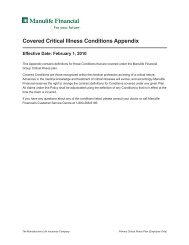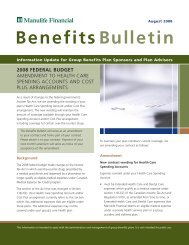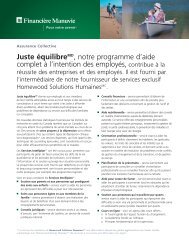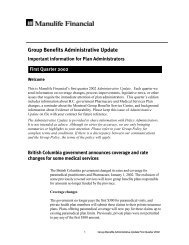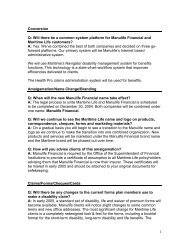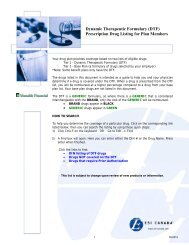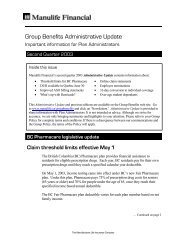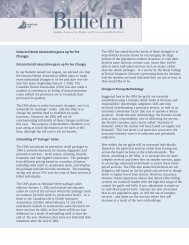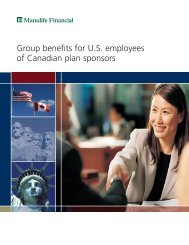Return To Work An Employee's Guide - Manulife - Manulife Financial
Return To Work An Employee's Guide - Manulife - Manulife Financial
Return To Work An Employee's Guide - Manulife - Manulife Financial
Create successful ePaper yourself
Turn your PDF publications into a flip-book with our unique Google optimized e-Paper software.
<strong>Return</strong> <strong>To</strong> <strong>Work</strong><strong>An</strong> Employee’s <strong>Guide</strong>Group Benefits
<strong>Return</strong>ing to work following an absence can often be the most critical phase of yourrecovery. How you handle the transition back to work may determine how successfulyou will be. Fortunately there are many things you can do to help prepare for asuccessful reintegration into the workplace.This guide outlines things you can do to help make your return to work smooth and successful. It providesinformation on steps you may want to consider before returning to work, on your first day back and throughoutyour return to work period. We believe that taking control of your return to work will not only benefit yourhealth but will also help your employer understand how they can best support you during this transitional period.Key concepts to Help you successFullymanage youR RetuRn to woRK1) <strong>Work</strong> is a key part of your recovery.nnnThe day-to-day physical and mental demands ofwork can help to recondition yourself followingan absence.The workplace provides the structure and routinenecessary to facilitate a successful recovery.Gradually incorporating work demands into yourrecovery may help to improve your chances ofstaying healthy. <strong>Work</strong> may benefit your overallhealth by providing structure and routine, socialinteraction and a sense of accomplishment.2) <strong>Return</strong>ing to work often requires an adjustment period.nnYou may not be able to fully perform the physicaland mental demands of your job in the same wayas prior to the onset of your condition. At timesyou may be frustrated, tired and worried aboutwhether or not you can be successful.You may require an accommodation to help yougradually reintegrate into the hours and dutiesrequired for your job.providers, and your <strong>Manulife</strong> <strong>Financial</strong> Disability CaseManager and Rehabilitation Specialist (if one is assigned).Talk to them about how you envision your return to work,your worries or concerns about returning, your motivation,your thoughts about what you can do to prepare and whatyou will need to assist your transition back to theworkplace. They are available to help you.HelpFul tIps:nnnClearly understand the return to work plan. What arethe hours? What work tasks are you responsible for?Who do you need to communicate with? Be an activeparticipant in the process and planning of your returnto work.Take steps to address problems early. If there areworkplace factors that may affect or exacerbate yourcondition, take steps to deal with them. This may meantalking to your manager and/or Human Resourcesrepresentative or developing strategies to deal withstressful situations positively and proactively.If you have been away for an extended period of time,it may be helpful to talk to your manager about anytraining you may need to effectively complete yourwork tasks.How do I get Ready FoR my RetuRnto woRK?Preparing to return to work may seem overwhelming,especially after being away from the workplace for anextended period of time. <strong>To</strong> help make your return to worksuccessful, it is important that you engage in the processas much as possible. Stay connected with your health carennnKnow where to go if you have questions or concerns.Establish what, if anything, you will communicate toothers about your absence.Develop support resources. Take an inventory of yourexisting support system. Your support system mayinclude your doctors and your <strong>Manulife</strong> <strong>Financial</strong>Disability Case Manager and/or Rehabilitation Specialist.It may also include your Employee Assistance Program,2
nnyour Human Resources representative at work, family,friends and community. Know that you will need extrasupport during the return to work. This can meaninforming family, friends, physicians or other healthcare providers about your return and letting themknow how they may be of help to you.Get regular exercise every day and maintain ahealthy diet.Establish a healthy sleeping routine.wHat KInd oF accommodatIons canI expect?The purpose of workplace accommodations is to helpremove return to work barriers for individuals withdisabilities. Accommodations should be assessed on anindividual basis. They should meet your needs as theyrelate to your medical condition and they should bebased on the resources available to your employer.Accommodation examples may include (but are notlimited to) the following:nHours – graduated return to work, flex time to attendappointments, balance work/life, non-standard breaksduring the work day.wHat sHould I do on my FIRst day bacK?Your first day back at work is a big step in the rightdirection, especially if you have a plan. Here are some tipsthat may help make it successful:nnnnnReview the return to work plan with your manager tohelp ensure you both understand it, including how youwill evaluate success and address issues.Discuss things like workload, job duties andperformance to clarify your expectations and yourmanagers expectations align.Discuss any extra training or reintegration time/resourcesthat may be required.Validate that you have an easily accessible list ofresources should you run into difficulties or beginto feel overwhelmed.Try to get back into a regular work routine.wHat sHould I tell my manageR?Your manager plays a critical role in your return to work.Maintain an open and honest approach. Assess yoursituation and decide what you should tell your manager. Afew suggested considerations and reflections are as follows:nnnnDuties – modification of work tasks, elimination of nonessentialtasks during the return to work, allowing extratime to complete tasks.Modification of work environment – lighting, noiseor other distractions.Supervision – changing the way direction is provided(e.g., in writing or allowing you to tape record),prioritization of tasks.Additional training or coaching – providing a buddysystem for additional support.nnWhat are you comfortable telling your manager? Keepin mind that saying nothing can lead to problems asthey might mistakenly confuse your medical conditionwith performance problems. Find a balance betweenyour own privacy and helping your manager understandyour situation.Keep details to a minimum. Use general terms likeillness or disability versus the specific diagnosis and/ortreatment. It is entirely at your discretion in terms ofhow much information you are comfortable disclosingto your manager.A “one size fits all” approach will not work. We believethe accommodation for your personal situation should beassessed accordingly.nHow does your medical condition affect your abilityto work?3
nnHow can your manager help? This may involveworkplace accommodations, looking out for signsof problems, identifying situations that may be moredifficult or challenging, and the best way for themto communicate with you if they have concerns.Is your employer able to provide additional supportand resources?nHave a plan to immediately deal with frustrations. Takea break or go for a walk. Inform your manager aheadof time so they are aware this may happen.n Be aware of and use the resources at your disposal –your physician or other health care providers,Employee Assistance Program, your <strong>Manulife</strong> <strong>Financial</strong>Rehabilitation Specialist and/or Disability Case Manager.nnTake the opportunity to reinforce your skills, abilitiesand commitment to the company.Once you have established what you will share withyour manager, you may want to consider discussingwith them how to approach communicating withco-workers about your situation.wHat sHould I tell my co-woRKeRs?Your approach to talking to your co-workers will dependhighly on what you deem to be appropriate. Details ofyour absence are private and confidential. Only youcan determine whether or not you want to share thisinformation, and with whom. If you are unsure of thebest approach, talk to a third party such as HumanResources or Employee Health when available.wHat IF I am HavIng dIFFIcultIes duRIngmy RetuRn to woRK?Despite being prepared to return to work, you mayencounter hurdles along the way. <strong>To</strong> help avoid asetback, you may want to keep in mind a few ofthe following considerations:nRecognize the early signs of trouble. These may include,getting easily agitated or frustrated with others or withtasks, not being able to block out distractions, havingdifficulty focusing, or simply not performing to the levelyou are used to.nnnnIf there are workplace factors causing problems,proactively address these with your manager andcome up with solutions together.Address problems early so they don’t negativelyimpact your recovery.Determine if changes/adjustments may be madeto the return to work plan.It is important to always maintain focus on yourrecovery. After returning to work, continue with yourtreatment and see your health care providers regularly,or as needed.wHeRe can I go IF I need moRe suppoRt?nnnUnderstand what resources your employer hasavailable (Employee Assistance Program, etc.).Your Physician or Therapist (if you are seeing one).Some helpful online resources:- www.mentalhealthworks.ca(Mental Health <strong>Work</strong>s – a great resource for tools, tipsand information on mental health and the workplace)- http://www.iwh.on.ca(Institute for Health and <strong>Work</strong> – a non-profitorganization dedicated to promoting, protectingand improving the health of workers)- http://www.phac-aspc.gc.ca/chn-rcs(Public Health Agency of Canada)Please be advised that the contents of this brochure are for informational and educational purposes only and should in no way be considered as <strong>Manulife</strong> <strong>Financial</strong> Group Benefits offering medical advice. Please consult with your attending family physician(s) or other health careprovider(s) as may be needed. WellConnected ® is offered through <strong>Manulife</strong> <strong>Financial</strong>. <strong>Manulife</strong> <strong>Financial</strong> is not responsible for the availability or content of external websites. © 2011 The Manufacturers Life Insurance Company. All rights reserved. <strong>Manulife</strong>, <strong>Manulife</strong> <strong>Financial</strong>, the <strong>Manulife</strong><strong>Financial</strong> For Your Future logo and the Block Design are trademarks of The Manufacturers Life Insurance Company and are used by it, and by its affiliates under license.GC2328E 03/2011



